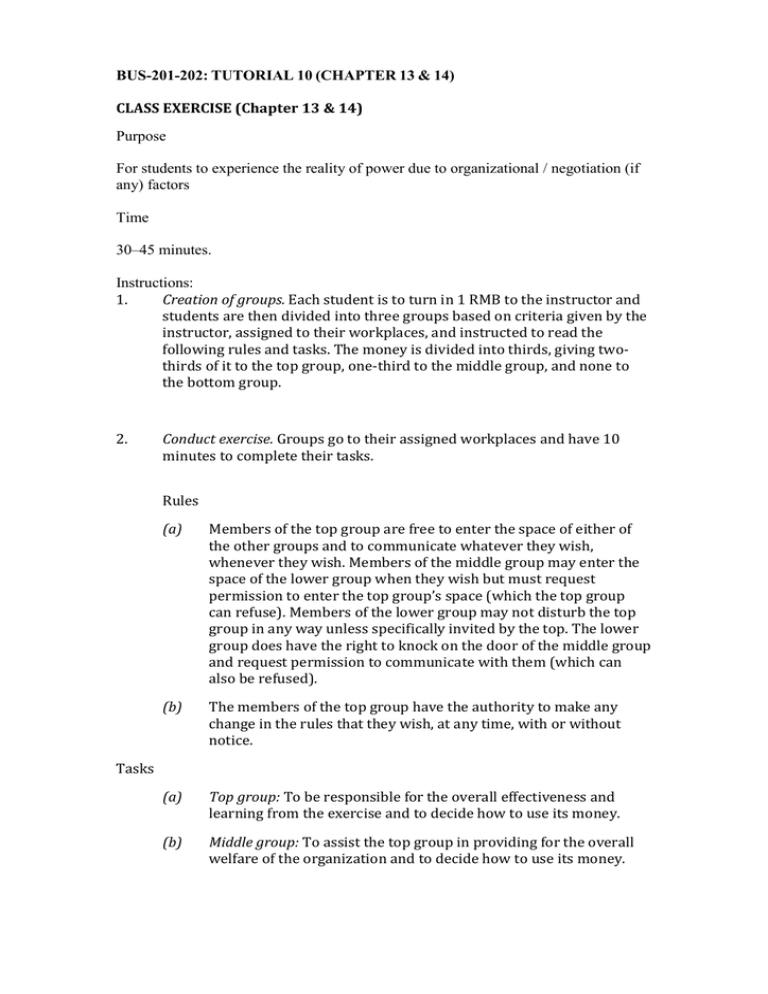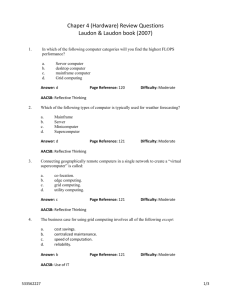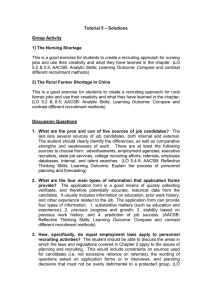30–45 minutes.
advertisement

BUS-201-202: TUTORIAL 10 (CHAPTER 13 & 14) CLASS EXERCISE (Chapter 13 & 14) Purpose For students to experience the reality of power due to organizational / negotiation (if any) factors Time 30–45 minutes. Instructions: 1. Creation of groups. Each student is to turn in 1 RMB to the instructor and students are then divided into three groups based on criteria given by the instructor, assigned to their workplaces, and instructed to read the following rules and tasks. The money is divided into thirds, giving twothirds of it to the top group, one-third to the middle group, and none to the bottom group. 2. Conduct exercise. Groups go to their assigned workplaces and have 10 minutes to complete their tasks. Rules (a) Members of the top group are free to enter the space of either of the other groups and to communicate whatever they wish, whenever they wish. Members of the middle group may enter the space of the lower group when they wish but must request permission to enter the top group’s space (which the top group can refuse). Members of the lower group may not disturb the top group in any way unless specifically invited by the top. The lower group does have the right to knock on the door of the middle group and request permission to communicate with them (which can also be refused). (b) The members of the top group have the authority to make any change in the rules that they wish, at any time, with or without notice. (a) Top group: To be responsible for the overall effectiveness and learning from the exercise and to decide how to use its money. (b) Middle group: To assist the top group in providing for the overall welfare of the organization and to decide how to use its money. Tasks (c) 3. Bottom group: To identify its resources and to decide how best to provide for learning and the overall effectiveness of the organization. Debriefing. Each of the three groups chooses 1 representative to go to the front of the class and discuss the following questions: (a) Summarize what occurred within and among the three groups. (b) What are some of the differences between being in the top group versus being in the bottom group? (c) What can we learn about power from this experience? (d) How accurate do you think this exercise is in reflecting the reality of resource allocation decisions in large organizations? REVIEW QUESTIONS (CHAPTER 13) 1. Define power and contrast leadership and power. Answer: Power refers to a capacity that A has to influence the behavior of B, so that B acts in accordance with A’s wishes. Power may exist but not be used. It is, therefore, a capacity or potential. Probably the most important aspect of power is that it is a function of dependency. The greater B’s dependence on A, the greater is A’s power in the relationship. Dependence, in turn, is based on alternatives that B perceives and the importance that B places on the alternative(s) that A controls. A person can have power over you only if he or she controls something you desire. Leadership is different from power in goal compatibility. Leadership requires goal congruence while power requires dependence not goal compatibility. A second difference relates to the direction of influence; leadership focuses on the downward influence on followers, power does not. Thirdly, the research on leadership has focused on style. Research on power has focused on tactics for gaining compliance. (This exercise covers Learning Objectives: Define power and contrast leadership and power; Learning Outcomes: Explain the effects of power and political behavior on organizations; and AACSB Learning Goals: Reflective thinking skills.) 2. Contrast the five bases of power? Answer: 1. 2. 3. 4. 5. Coercive Power - A power base dependent on fear of negative results valuable Reward Power - Compliance achieved based on the ability to distribute rewards that others view as valuable Legitimate Power - The formal authority to control and use resources based on a person’s position in the formal hierarchy Expert Power - Influence based on special skills or knowledge Referent Power - Influence based on possession by an individual of desirable resources or personal traits (This exercise covers Learning Objectives: Contrast the five bases of power; Learning Outcomes: Explain the effects of power and political behavior on organizations; and AACSB Learning Goals: Reflective thinking skills.) 3. Explain the role of dependence in power relationships. Answer: Probably the most important aspect of power is that it is a function of dependency. The greater B’s dependence on A, the greater is A’s power in the relationship. Dependence, in turn, is based on alternatives that B perceives and the importance that B places on the alternative(s) that A controls. (This exercise covers Learning Objectives: Explain the role of dependence in power relationships; Learning Outcomes: Explain the effects of power and political behavior on organizations; and AACSB Learning Goals: Reflective thinking skills.) 4. Identify nine power or influence tactics and their contingencies. Answer: 1. Legitimacy. Relying on your authority position or saying a request accords with organizational policies or rules. 2. Rational persuasion. Presenting logical arguments and factual evidence to demonstrate a request is reasonable. 3. Inspirational appeals. Developing emotional commitment by appealing to a target’s values, needs, hopes, and aspirations. 4. Consultation. Increasing the target’s support by involving him or her in deciding how you will accomplish your plan. 5. Exchange. Rewarding the target with benefits or favors in exchange for following a request. 6. Personal appeals. Asking for compliance based on friendship or loyalty. 7. Ingratiation. Using flattery, praise, or friendly behavior prior to making a request. 8. Pressure. Using warnings, repeated demands, and threats. 9. Coalitions. Enlisting the aid or support of others to persuade the target to agree. (This exercise covers Learning Objectives: Identify nine power or influence tactics and their contingencies; Learning Outcomes: Explain the effects of power and political behavior on organizations; and AACSB Learning Goals: Reflective thinking skills.) 5. Show the connection between sexual harassment about the abuse of power? Answer: Sexual harassment is any unwanted activity of a sexual nature that affects an individual’s employment and creates a hostile work environment. Sexual harassment isn’t about sex: it is about abusing an unequal power relationship. Harassment can damage the well-being of the individual, work group, and organization. (This exercise covers Learning Objectives: Show the connection between sexual harassment and abuse of power; Learning Outcomes: Explain the effects of power and political behavior on organizations; and AACSB Learning Goals: Reflective thinking skills.) 6. Identify the causes and consequences of political behavior? Answer: There are both individual and organizational factors involved. 1. Individual factors. Researchers have identified certain personality traits, needs, and other factors that are likely to be related to political behavior a. Traits—employees who are high self-monitors, possess an internal locus of control, and have a high need for power are more likely to engage in political behavior. i. The high self-monitor is more sensitive to social cues and is more likely to be skilled in political behavior than the low self-monitor. ii. Individuals with an internal locus of control are more prone to take a proactive stance and attempt to manipulate situations in their favor. iii. The Machiavellian personality is comfortable using politics as a means to further his/her self-interest. b. An individual’s investment in the organization, perceived alternatives, and expectations of success will influence the tendency to pursue illegitimate means of political action. 2. Organizational factors. Political activity is probably more a function of the organization’s characteristics than of individual difference variables. When an organization’s resources are declining, when the existing pattern of resources is changing, and when there is opportunity for promotions, politics is more likely to surface. a. Organizational culture is characterized by low trust, role ambiguity, etc. b. Making organizations less autocratic by asking managers to behave more democratically is not necessarily embraced by all individual managers. (This exercise covers Learning Objectives: Identify the causes and consequences of political behavior; Learning Outcomes: Explain the effects of power and political behavior on organizations; and AACSB Learning Goals: Reflective thinking skills.) 7. Apply impression management techniques. Answer: This is the process by which individuals attempt to control the impression others form of them. We know that people have an ongoing interest in how others perceive and evaluate them. Being perceived positively by others should have benefits for people in organizations. Some IM techniques include: 1. Conformity 2. Excuses 3. Apologies 4. Self-Promotion 5. Flattery 6. Favors 7. Association (This exercise covers Learning Objectives: Apply impression management techniques; Learning Outcomes: Explain the effects of power and political behavior on organizations; and AACSB Learning Goals: Reflective thinking skills.) 8. Determine whether a political action is ethical? Answer: There is no obvious or clear-cut way but there are 3 questions that may help: 1. What is the utility of engaging in the behavior? 2. Does the utility balance out any harm done by the action? 3. Does the action conform to standards of equity and justice? (This exercise covers Learning Objectives: Determine whether a political action is ethical; Learning Outcomes: Explain the effects of power and political behavior on organizations; and AACSB Learning Goals: Ethical understanding and reasoning abilities, Reflective thinking skills.) REVIEW QUESTIONS (CHAPTER 14) 1. What is conflict? Answer: Conflict is a process that begins when one party perceives that another party has negatively affected, or is about to negatively affect, something that the first party cares about. (This exercise covers Learning Objectives: Define conflict; Learning Outcomes: Describe the nature of conflict and the negotiation process; and AACSB Learning Goals: Reflective thinking skills.) 2. What are the differences among the traditional, interactionist and managed conflict views of conflict? Answer: The traditionalist view of conflict is the belief that all conflict is harmful and must be avoided. The managed-conflict view of conflict is the belief that conflict is a natural and inevitable outcome in any group. The current view is the interactionist view of conflict or the belief that conflict is not only a positive force in a group but also that it is absolutely necessary for a group to perform effectively. (This exercise covers Learning Objectives: Differentiate between the traditional, human relations, and interactionist views of conflict; Learning Outcomes: Describe the nature of conflict and the negotiation process; and AACSB Learning Goals: Reflective thinking skills.) 3. What are the steps of the conflict process? Answer: The process is diagrammed in Exhibit 14–1. Stage I: Potential opposition or incompatibility—The first step in the conflict process is the presence of conditions that create opportunities for conflict to arise. These conditions have been condensed into three general categories: communication, structure, and personal variables. Stage II: Cognition and personalization—The antecedent conditions can lead to conflict only when one or more of the parties are affected by, and aware of, the conflict. Just because a conflict is perceived does not mean that it is personalized. It is important because it is where conflict issues tend to be defined. Stage III: Intentions—Intentions are decisions to act in a given way. Exhibit 14–2 represents one author’s effort to identify the primary conflict-handling intentions. Two dimensions—cooperativeness and assertiveness. Five conflict-handling intentions can be identified: competing (assertive and uncooperative), collaborating (assertive and cooperative), avoiding (unassertive and uncooperative), accommodating (unassertive and cooperative), and compromising (midrange on both assertiveness and cooperativeness). Stage IV: Behavior—The behavior stage includes the statements, actions, and reactions made by the conflicting parties. These conflict behaviors are usually overt attempts to implement each party’s intentions. Exhibit 14–3 provides a way of visualizing conflict behavior. Exhibit 14–4 lists the major resolution and stimulation techniques that allow managers to control conflict levels. Stage V: Outcomes—Outcomes may be functional in that the conflict results in an improvement in the group’s performance, or dysfunctional in that it hinders group performance. Conflict is constructive when it improves the quality of decisions, stimulates creativity and innovation, etc. Dysfunctional outcomes uncontrolled opposition breeds discontent, which acts to dissolve common ties, and eventually leads to the destruction of the group. Among the more undesirable consequences are a retarding of communication, reductions in group cohesiveness, and subordination of group goals to the primacy of infighting between members. (This exercise covers Learning Objectives: Outline the conflict process; Learning Outcomes: Describe the nature of conflict and the negotiation process; and AACSB Learning Goals: Reflective thinking skills.) 4. What is negotiation? Answer: Negotiation is a process in which two or more parties exchange goods or services and attempt to agree on the exchange rate for them. (This exercise covers Learning Objectives: Define negotiation; Learning Outcomes: Describe the nature of conflict and the negotiation process; and AACSB Learning Goals: Reflective thinking skills.) 5. What are the differences between distributive and integrative bargaining? Answer: Distributive Bargaining is negotiation that seeks to divide up a fixed amount of resources; a win-lose situation. Integrative Bargaining is negotiation that seeks one or more settlements that can create a win-win solution. Exhibit 14-5 shows that these approaches to bargaining differ in their goal and motivation, focus, interests, information sharing and duration of relationship. (This exercise covers Learning Objectives: Contrast distributive and integrative bargaining; Learning Outcomes: Describe the nature of conflict and the negotiation process; and AACSB Learning Goals: Reflective thinking skills.) 6. What are the five steps in the negotiation process? Answer: Exhibit 14-7 shows a model of the negotiation process. It includes the preparation and planning, definition of ground rules, clarification and justification, bargaining and problem solving, and closure and implementation. (This exercise covers Learning Objectives: Apply the five steps of the negotiation process; Learning Outcomes: Describe the nature of conflict and the negotiation process; and AACSB Learning Goals: Reflective thinking skills.) 7. How do the individual differences of personality and gender influence negotiations? Answer: Personality and gender can both influence negotiations. Personality traits like extroverts and agreeable people are weaker at distributive negotiation. In contrast, disagreeable introverts are best at this type of negotiation. Intelligence is also a weak indicator of bargaining. Effectiveness. With gender, men and women negotiate the same way, but may experience different outcomes. Women and men take on gender stereotypes in negotiations such as tender and tough. In addition, women are less likely to negotiate. (This exercise covers Learning Objectives: Show how individual differences influence negotiations; Learning Outcomes: Describe the nature of conflict and the negotiation process; and AACSB Learning Goals: Reflective thinking skills.) 8. What are the roles and functions of third-party negotiations? Answer: There are four basic third-party roles: Mediator - A neutral third party who facilitates a negotiated solution by using reasoning, persuasion, and suggestions for alternatives. Arbitrator - A third party to a negotiation who has the authority to dictate an agreement. Conciliator - A trusted third party who provides an informal communication link between the negotiator and the opponent. Consultant - An impartial third party, skilled in conflict management, who attempts to facilitate creative problem solving through communication and analysis. (This exercise covers Learning Objectives: Assess the roles and functions of thirdparty negotiations; Learning Outcomes: Describe the nature of conflict and the negotiation process; and AACSB Learning Goals: Reflective thinking skills.)





